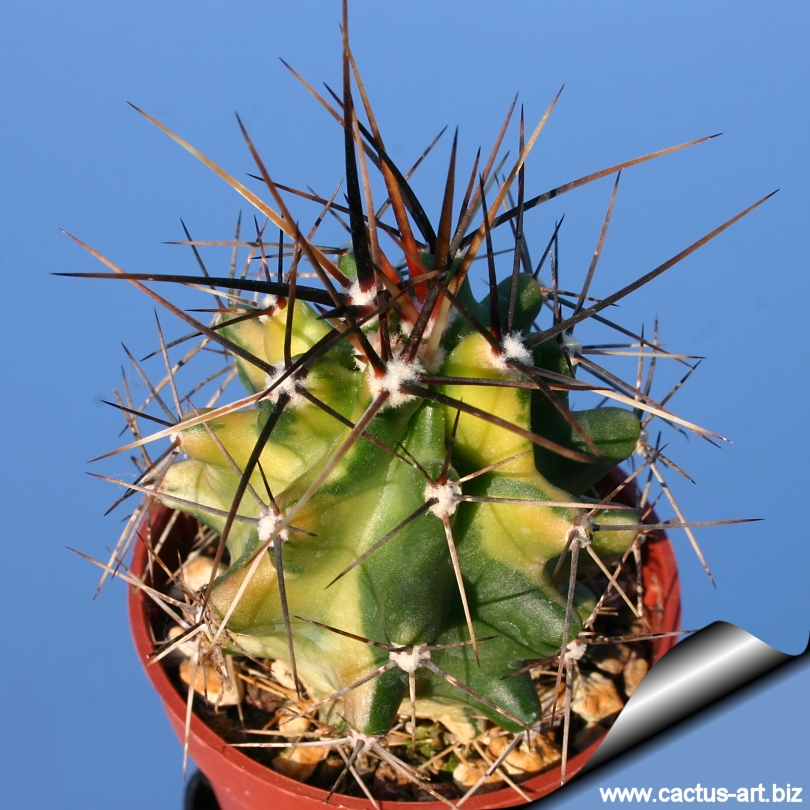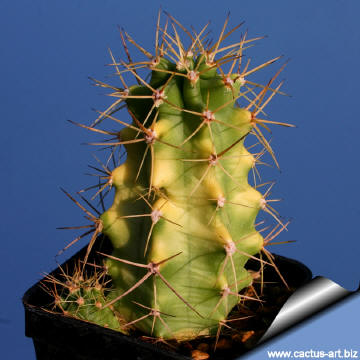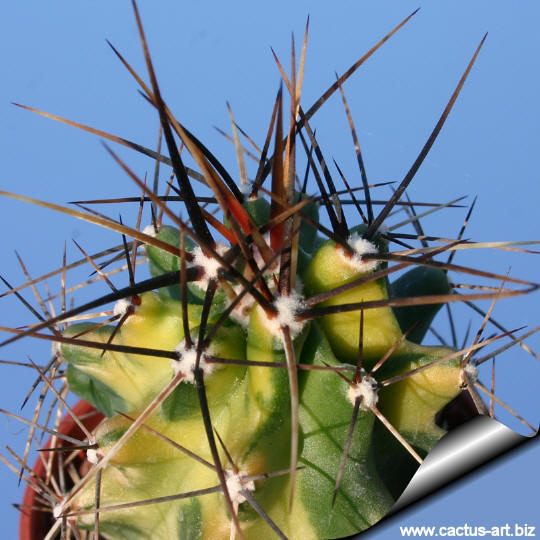|
|
|

Echinocereus triglochidiatus forma variegata
|
|
Description:
The Echinocereus triglochidiatus is a mounding cactus, forming bulbous
piles of from a few to hundreds of spherical to cylindrical stems.
Plants may vary from densely spiny (usually) to no spines at all. E.
triglochidiatus is the most wide-spread of the Echiniocereus species and
is also the most variable in appearance. I n fact, the several varieties
are so different-looking that the only uniting factor is the bright red
bloom and rounded petals.
Stems: Usually erect , spherical or cylindrical, 3-70 cm tall,
5-13 cm in diameter;
Ribs: 5-8 or 8-12, crests slightly undulate (some populations
contain plants with strongly interrupted ribs);
Areoles: 10-40 mm apart,
and somewhat woolly.
Spines (0-)3-11 per areole, with central spines being difficult
to distinguish from the radial spines. Straight to curved or contorted,
appressed (radial spines) or spreading to projecting outward (some
radials, and central spines when present), white to yellow, gray, or
sometimes nearly black, but those turn whitish-grey after their first
season.
Radial spines: (0-)1-10 per areole, (0-)15-90 mm long;
Spines are at first yellow, pink or black.
Central spines: 0-1(-4) per areole, angular, (0-)50-120 mm long.
Flowers: Diurnal, funnel-shaped,
5-10 × 3-7 cm; flower tube 20-35 mm; flower tube hairs 1-2 mm; inner
tepals bright orange-red to dark red, proximally paler (bases sometimes
yellow or white), 25-40 × 10-15 mm, tips thick and rigid; anthers
usually pink to purple.
There is a thick nectar chamber and many thready pink stamens at the
center of the corolla. The flowers are pollinated by hummingbirds.
Fruits: Juicy, with deciduous spines, and edible, green to
yellow-green or pink (rarely red), (15-)20-35 mm, pulp white,
fruiting 2-2.5 months after flowering...
Blooming season: Apr-June,
the flowers remain open for 2 or 3 days.
Blooming
generally begins 5 to 10 years after sowing,
as the plant matures.
|
|
 |
 |
|
Photo of conspecific taxa, varieties, forms
an cultivars of Echinocereus triglochidiatus.
|
|
Advertising
|
|
|
|
|
Family:
Cactaceae (Cactus
Family)
Scientific name:
Echinocereus
triglochidiatus Engelmann
in F. A. Wislizenus, Mem. Tour N. Mexico. 93. 1848.
Origin:
Garden origin (Nursery
produced cultivar)
Conservation status: Listed in
CITES appendix 2.
Synonyms:
- Cereus triglochidiatus
Engelmann 1848
- Cereus gonacanthus
- Echinocereus
triglochidiatus var.
gonacanthus (Engelmann & J. M. Bigelow) Boissevain
- Echinocereus
paucispinus var. triglochidiatus Schumann 1896
- Echinocereus
triglochidiatus var. paucispinus
- Echinocereus triglochidiatus var.
mojavensis (Engelmann & J. M. Bigelow) L. D. Benson
- Echinocereus triglochidiatus var.
inermis (Schumann) Arp
Common Name: Claret-Cup
Hedgehog , Kingcup cactus, mound cactus, King's Crown Cactus, Spineless
Hedgehog,
Strawberry Cactus.,
Mound Cactus, Crimson Hedgehog, Claretcup Hedgehog, Curve-Spined Claret
Cup,, Mojave Hedgehog, Mojave Kingcup Cactus, Mojave Mound Cactus, Mound
Hedgehog-Cactus.
Etymology:
The genus name
Echinocereus
comes
from the Greek word "εχινος (Echinos)" meaning"
Sea-urchin
or
Hedgehog"
The species name "triglochidiatus" is formed by the prefix
“tri” meanening “three (3)” plus the Latin
word “glochidium” a “barbed hair of a plant
or a spine”
referring to the spines
found on areoles along the ribs, but not all
the plants bear clusters of three spines,
and usually more than three spines are found
in each cluster.
|
|
Photo of conspecific taxa, varieties, forms an cultivars of
Echinocereus triglochidiatus.
|
|
|
|

Variegation: A variegated plant has sectors, patches or stripes
with two or more different colours, even distinct shades of green.
Plants with variegated stems or leaves are often
attractive and
highly prized.
In most species the
stems or leaves are normally green, and variegated epidermis is an
uncommon
mutation, termed a
chimera. A chimeral variegation is due to losing the ability to
produce
chlorophyll in some of the plant’s
tissue, so that this tissue is no longer green. Tissues lacking
chlorophyll are usually white or pale yellow coloured (due to
carotenoid
pigments) or red (due to
betalain or
anthocyanin pigments) contrasting with the normal green tissue.
There are several forms of variegation, depending on the tissues that
have been affected. The variegation in some forms is unstable. The
extent and nature of the variegation can vary, and sometimes the plant
will return to the green form. In others it is stable and does not
change under normal conditions. Because the variegation is due to the
presence of two kinds of plant tissue, propagating the plant must be by
a
vegetative method of
propagation that preserves both types of tissue in relation to each
other.
Variegated Echinocereus are very rare and priced
in
cultivation. All variegates are
mutants. Something has gone wrong with the cellular structure of the
growth tip (apical
meristem) of the plant. As a result of this mutation,
chlorophyll is missing from some or all layers of the plant
epidermis. The odd variegate appears in many seedling batches in a
small percentage, and is generally separated from normal plants.
Variegated plants grow more slowly, and are generally smaller than
non-variegates of the same species. Coloured areas are also generally
weaker, and more
susceptible to
fungus,
sunburn and other defects. A large well grown variegate
Echinocereus
is truly an achievement. These are harder to grow well than they appear.
|
|